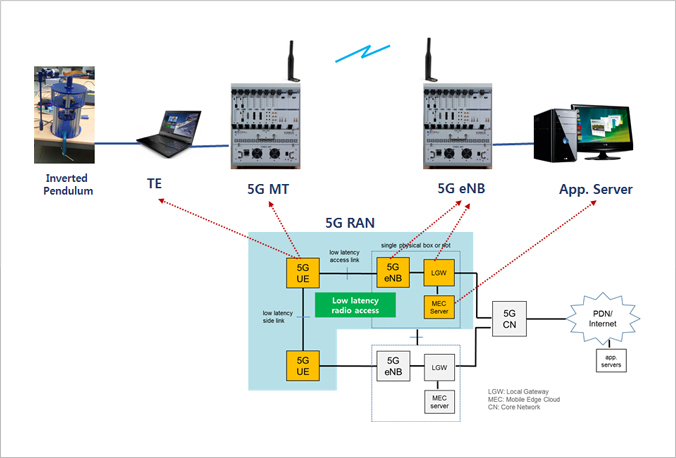
Low-Latency Technology for
Realistic Internet Experience
5G Low-Latency Mobile Telecommunications Technology
Era of 5G low latency
With the arrival of an era of 5G mobile telecommunications, the world is witnessing increasing services for remote robot control, self-driving cars, drone control, and telemedicine. Such 5G mobile communication services necessarily require fast transmission speed, connection with a large number of devices, and prevention of transmission latency. In particular, it is critical to reduce the time spent when data transmitted from smartphones and other devices return to them again via stations and servers within the mobile communication networks.
ETRI researchers have successfully developed the core technology for 5G mobile communication to minimize such service latency. In a test using an inverted pendulum, they reduced the service delay of 0.02 second (20ms) in 4G mobile communication by one-tenth to 0.002 second (2ms), verifying the 5G low-latency mobile communication technology. Considering that it takes approximately 50ms for human beings to perceive objects visually and aurally, the reduced speed is a maximum 25 times faster.
The recently developed 5G low-latency technology can be applied in a wide range of areas. For instance, it can be used for V2X (vehicle to everything) to prevent automobile collisions by instantly informing cars about an accident in front of them. The low-latency technology can be also applied to services directly related to human life, such as telemedicine systems where it is necessary to understand a patient’s condition during surgery and take real-time control of surgical equipment. Other useful applications of low-latency technology include smart factories, drone control, real-time remote robot control with precision, and augmented reality.

※ Inverted pendulum: This device strikes a balance by moving an inverted pendulum having a center of gravity on the upper side. The motion control depending on the pendulum’s location must be done in real time without latency. In this demonstration, the motion control part of the inverted pendulum is placed in the application server behind a station, for remote control of the inverted pendulum.
Reliable low-latency data transmission
The essence of 5G low-latency technology is to break from the 4G mode of sending data at a 1ms interval in the wireless section between devices and stations and instead to transmit data swiftly at an interval that is one-seventh shortened from that in the 4G mode. Other essential elements include the structure of simultaneously accommodating 4G and 5G devices, the technology to minimize the time for perceiving incoming data, and the technology to optimally allocate control signals and reference signals.
To verify the core technology for 5G low-latency mobile communication, ETRI has completed the development of a testbed consisting of a device, station, and application server. This technology will be embedded within smartphones or other devices as communication model chips and within base stations as chips or software. As it will ensure highly reliable, low-latency data transmission in the 5G environment, tactile Internet service is expected to be available in the near future. The time of delay, approximately 1ms, is at the level of tactile sensitivity, which human beings can perceive more quickly than any other senses.

5G-related core original technology for an era of 5G telecommunications
With the 3GPP (3G Partnership Project) beginning in 2016 the standardization process of 5G mobile communication technologies including low-latency technology, Korea is currently in a favorable position to lead the 5G low-latency technology. Dr. Hyun Kyu Chung of the 5G Giga Communication Research Laboratory explained, “This core 5G technology will allow us to discover new application services and business models that require extremely short latency in mobile networks.” Director Jin-hyo Park of SK Telecom Network Technology R&D Center, a joint research partner, stated, “Network innovation such as the 5G low-latency technology we developed with ETRI is expected to deliver innovation of experience to customers through differentiated 5G service.”
In addition to the 5G low-latency mobile technology, ETRI is preparing for the 5G era by developing core original technologies based on continued advanced research and standardization of large-capacity wireless transmission technology and connection technology for a large number of devices.
